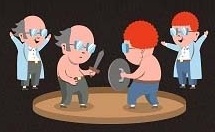.08% Injurious Exposure of 30-year Career Sufficient for California Jurisdiction
As Assembly Bill 1309 sits on Governor Brown’s desk, hoping to bar a whole mob of professional athletes from the hallowed halls of the workers’ compensation venues, one group of workers get to continue enjoying California workers’ compensation benefits for non-California work.
For your consideration, I bring to you the case of Jessie Kenlaw v. Houston Comets. Ms. Kenlaw worked as basketball coach from 1978 through 2008, and visited California a few times in 2007. The main argument raised in this case was a jurisdictional one: defendant argued that injurious exposure in California is not sufficient for invoking jurisdiction – there has to be an actual injury in California for the defendant to get sucked into California’s meat grinders.
The argument is sensible enough – it’s not right to invoke California jurisdiction for a workers’ comp claim when the vast majority of the “exposure” is outside of California. After all, we’re not talking about a situation in which the worker was in California for one day out of a 20 year career, but there was a specific injury here.
The Workers’ Compensation Judge, and the Workers’ Compensation Appeals Board, both rejected the argument. The applicant’s burden is only to establish through substantial medical evidence that her work activities were a contributing cause of her injury, and in cumulative trauma claims, that’s pretty easy to do, because there’s nothing specific that causes the injury, but rather the job in general.
The facts show that applicant coached three games in California, and for each game she arrived in California two days early. She participated in practice sessions and did coaching work.
But we’re talking about a cumulative trauma period from January 1, 1978 to July 1, 2008. And for nine days (out of 11,139, or 0.08%) applicant now invokes California jurisdiction.
Although without much legal support, the defense put forth a good theory – it’s roots were in logic, justice, and basic fairness.
By the by, dear readers, if you’re at all concerned about the businesses leaving California, you should also look at these decisions as a reason why employers might not want to send their workers into California, even for a little while.
Perhaps at the next legislative reform happy hour, someone could pipe up about amending the Labor Code to require significant injurious exposure for workers temporarily in California before allowing workers’ compensation jurisdiction to be invoked.
That would be a… wait for it… slam dunk!
